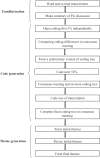Pre-operative rehabilitation for dysvascular lower-limb amputee patients: A focus group study involving medical professionals
- PMID: 30321178
- PMCID: PMC6188752
- DOI: 10.1371/journal.pone.0204726
Pre-operative rehabilitation for dysvascular lower-limb amputee patients: A focus group study involving medical professionals
Abstract
Background: Major lower-limb amputation (LLA) predisposes patients post-operatively to a significant decline in daily-life functioning. The physical condition of amputee patients prior to surgery is significantly deteriorated due to chronic peripheral vascular disease (PVD) and diabetes, which accounts for the majority of LLAs in the adult population. A common strategy called pre-rehabilitation has been used in multiple patient populations to prepare the patient for undergoing a surgical event and to improve post-operative patient outcomes. Pre-rehabilitation might enhance the outcome of dysvascular LLA patients and reduce the high post-operative mortality rates. However, experience of experts with pre-rehabilitation and feasibility of a pre-rehabilitation program in this group remains unknown.
Objective: To investigate the experiences of medical professionals and researchers in the field of LLA with the use of pre-rehabilitation in general and in particular PVD patients. Additionally, the study examines their opinions regarding need for and feasibility of a pre-rehabilitation program for dysvascular patients at risk for an LLA.
Methods: Two explorative focus group discussions were organized with in total 16 experts in the field of treatment and research of LLA. Transcribed data were coded using the Atlas.ti software package. Thematic analysis with inductive approach was opted to arrange and interpret codes.
Results: The experiences of the experts with pre-rehabilitation in dysvascular patients were scarce. The experts described dysvascular patients at risk for an LLA as a difficult group for pre-rehabilitation due to short time window prior to surgery, older age, multiple co-morbidities and lack of motivation for behavioral change. The experts concluded that a pre-rehabilitation program should focus on patients who have sufficient time in advance before the amputation for pre-rehabilitation and who are motivated to participate.
Conclusion: Although in general the effects of pre-rehabilitation are promising, pre-operative rehabilitation in dysvascular patients at risk for an LLA seems not feasible. Future research could focus on a better monitoring of dysvascular patients and the development of pre-rehabilitation in subgroups of younger dysvascular LLA patients.
Conflict of interest statement
The authors have declared that no competing interests exist.
References
-
- Dillingham TR, Pezzin LE, MacKenzie EJ. Limb amputation and limb deficiency: epidemiology and recent trends in the United States. South Med J. 2002;95(8):875–83. - PubMed
-
- Andrews L, Anderson L, Fairbain S, Downing L. Care planning for children with lower limb amputation. Nursing Children & Young People. 2012;24(1):14–19. - PubMed
-
- Richtlijn amputatie en prothesiologie onderste extremiteit. Nederlandse Vereniging van Revalidatieartsen (VRA)/CBO. Oct 2012.
MeSH terms
LinkOut - more resources
Full Text Sources
Medical


